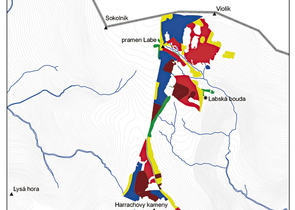Nature Conservation 2/2013 — 21. 6. 2013 — Nature and Landscape Management — Print article in pdf
Harčarik J.: Mountain Pine Growth Management in the Krkonoše Mts. National Park
v Krkonošském národním parku

In the Giant Mountains (Krkonoše in Czech, Riesengebirge in German, Karkonosze in Polish), Mountain Pine (Pinus mugo) growths occur particularly in habitats above the timberline, i.e.in the area which was defined as the Giant Mts. Arctic-Alpine tundra in the 1990s.
In addition to natural growths covering 1,502 hectares, there are also planted growths established in the 19th and 20th century (in total, 678 hectares). As a part of multidisciplinary research aiming at the tundra carried out in the two last decades, Mountain Pine interactions with the individual tundra phenomena were studied. It was found that regular and overdense Mountain Pine plantings, particularly those planted in the second half of the 20th century, distinguish sharply by their structure from natural growths. At the same time, the former negatively affect abiotic and biotic conditions in the Giant Mts. tundra. The open Alpine treeless habitats have been reduced in size and finally lost, wildlife populations preferring the native habitats have been declining, geomorphological phenomena have been mechanically damaged and microclimate conditions have been changing there. Therefore, a management plan was developed, proposing various reductions in size in the plantings covering 180 hectares and established after World War II., ranging from 10 to 90 %. The measure aims at establishing close to the Alpine treeless habitat natural structure in artificially established Mountain Pine growths, restoring natural processes and maintaining or restoring the Giant Mts. tundra geobiodiversity. In 2005–2011, the Mountain Pine growths on the Labská louka and Pančavská Louka sub-alpine meadows with a peat-bog were reduced in a total on 41 hectares.

